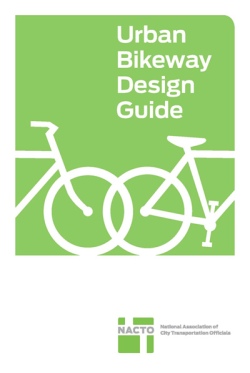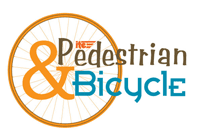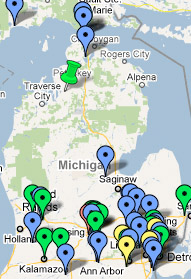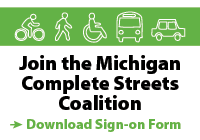You are currently browsing the tag archive for the ‘Safety’ tag.
 Earlier this month, Federal Highway Administration (FHWA) announced support for two guidelines, which can help communities, especially more urban ones, plan and design safe and convenient facilities for those who walk and/or bike.
Earlier this month, Federal Highway Administration (FHWA) announced support for two guidelines, which can help communities, especially more urban ones, plan and design safe and convenient facilities for those who walk and/or bike.
In the recent memorandum, the FHWA encourages its division throughout the nation to consider relying upon The National Association of City Transportation Officials (NACTO) Urban Bikeway Design Guide and the Institute of Transportation Engineers (ITE) Designing Urban Walkable Thoroughfares.
These guides build upon The American Association of State Highway and Transportation Officials (AASHTO) “green book”, which is the primary national resources for planning, designing, and operating bicycle and pedestrian facilities.
“The FHWA’s support for the NACTO guidelines gives communities and our state DOT an additional toolkit to help them provide safe and effective infrastructure that better serves bicyclists.” said John Lindenmayer, Advocacy & Policy Director for the League of Michigan Bicyclists. “Providing safe bicycle infrastructure that connects people to places goes along way to improve a bicyclists’ comfort level and overall feeling of safety on the road. These innovative bikeways certainly can play a big role in increasing ridership, which in and of itself, can help reduce the number of bicycle crashes within a community. It’s a win-win. This is an exciting opportunity for Michigan communities and LMB strongly encourages road agencies across the state to incorporate these design standards where appropriate.”
NACTO, which is an association of 15 major US cities (including Detroit) formed to exchange transportation ideas, insights, and practices and cooperatively approach national transportation issues, has published two editions of its bikeway design guide with with another edition set to be released on September 23, 2013. Unlike AASHTO’s more traditional guide, NACTO’s include protected bicycle lanes and other innovative best practices.
The FHWA memorandum also highlighted Michigan as a case study to illustrate use of treatments illustrated in the NACTO Guide by State or local DOTs:
Example 1: Michigan DOT’s Buffered Bike Lanes
One of the innovative bicycle facilities discussed in the NACTO Urban Bikeway Design Guide is buffered bike lanes. Buffered bike lanes create more space between motor vehicles and bicycles by delineating extra space between the bike lane and parked cars and/or a motor vehicle lane. Buffered bike lanes can be implemented if the pavement markings and channelizing devices are compliant with the MUTCD (see Bicycle Facilities and the Manual on Uniform Traffic Control Devices). Michigan DOT developed a video that describes their efforts to install buffered bike lanes in Oakland County (see Northwestern Highway Bicycle Lane: A Safer Place to Ride). Michigan DOT also developed a brochure that explains buffered bike lanes to the public (see What Every Michigan Driver Should Know About Bike Lanes).
The Ann Arbor City Council unanimously approved a new pedestrian safety ordinance last July that gives walkers and bicyclists the upper hand when trying to brave traffic to cross city streets.
It’s a new kind of share-the-road philosophy, and city officials acknowledge it will take time and education to change the current culture. In the words of Police Chief Barnett Jones, it’s an effort to stop pedestrians from “playing Frogger trying to cross our roadways.”
The ordinance change, brought forward by Council Member Carsten Hohnke and Mayor John Hieftje, clarifies the obligation of motorists to yield to pedestrians in crosswalks.
According to the new ordinance, when traffic control signals aren’t in place or aren’t in operation, the driver of a vehicle must stop and yield the right-of-way to every pedestrian not only within a crosswalk, but also pedestrians approaching a crosswalk.

Click graphic to learn more about the Institute of Transportation Engineers Pedestrian & Bicycle Council
At the 2009 ITE Annual Meeting in San Antonio, the last panel of the last day focused on pedestrian safety, with a presentation by Meghan Mitman on recent crosswalk research and another by me on potential changes to the vehicle code, driver’s manual and Manual on Uniform Traffic Control Devices (MUTCD) to improve driver and pedestrian comprehension of crosswalk right of way.
Research performed by Meghan with David Ragland and Charlie Zegeer in the early part of the 2000s revealed a very troubling phenomenon related to a basic understanding of who has the legal right of way at uncontrolled crosswalks. Their research focused on California, where the California Vehicle Code requires that drivers yield to pedestrians at crosswalks and defines crosswalks as an extension of a sidewalk across an intersection, regardless of whether it is marked. Their research shows that the more complex the intersection, the less comprehension there is among drivers and pedestrians about who has the legal right of way: At intersections where all legs are marked, comprehension was greatest; and at intersections where no crosswalks are marked, comprehension is the worst with nearly half of drivers not understanding that they are legally required to yield the right of way to pedestrians. Read the rest of this entry »
Taking a stroll? Ann Arbor is the safest city in Michigan to do it, while Flint is the most dangerous according to a national report released today.
Overall, the number pedestrians killed each year in Michigan is above the national average (12.2% in Michigan, compared with 11.8% nationally). Cities including Lansing, Grand Rapids and Jackson scored favorably, while Detroit, Monroe, and others scored well below the national average. Click here for the complete data on Michigan.
More than 4,500 Americans died last year while walking in the nation’s cities and towns. In Michigan, 253 pedestrian fatalities were recorded in 2007 and 2008.
The report—Dangerous by Design: Solving the Epidemic of Preventable Pedestrian Deaths—was authored by Transportation for America and the Surface Transportation Policy Partnership. It was released in Michigan through the Michigan Environmental Council.
The report shows that communities that invest in safe, complete streets — those that encourage pedestrians, cyclists and motorists to coexist safely — are the safest places to walk. Walk- friendly policies and infrastructure should be a key pillar of policies to encourage revitalization of urban cores throughout the state.
Unfortunately, only a trickle of transportation funding is used to address pedestrian safety. Pedestrian deaths account for 12 percent of all traffic deaths, yet only 1.5 percent of funds available in the current federal transportation bill are directed toward pedestrian safety.
PowerPoint dismisses liability concerns for constructing roadways that accommodate pedestrians and bicyclists
A must view PowerPoint for all Michigan road agencies, planners, engineers and politicians. Written by Ronald W. Emery (Transportation Division Dept. of Attorney General), Josh DeBruyn (Bicycle and Pedestrian Coordinator - MDOT) and Deirdre Thompson (Bicycle and Pedestrian Safety Engineer - MDOT), this PowerPoint demonstrates through case law that NO liability risk exists for accommodating nonmotorized facilities users through bike lanes, road diets, mid-block crossings or signing rural roads/shoulders as bike routes.
Download Presentation: Ped Bike Safety and Liability
Questions on this presentation can be directed to:
Josh DeBruyn, AICP
Bicycle and Pedestrian Coordinator
Bureau of Transportation Planning
Michigan Department of Transportation
517-335-2918















